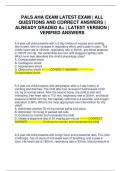PALS AHA EXAM LATEST EXAM | ALL
QUESTIONS AND CORRECT ANSWERS |
ALREADY GRADED A+ | LATEST VERSION |
VERIFIED ANSWERS
A 3-year-old child presents with a 2-day history of nausea and vomiting.
She is alert, with no increase in respiratory effort, and is pale in color. The
child's heart rate is 160/min, respiratory rate is 40/min, and blood pressure
is 100/70 mm Hg. Her extremities are cool, with sluggish capillary refill.
Which term best describes this child's physiologic state?
A. Compensated shock
B. Cardiogenic shock
C. Hypotensive shock
D. Obstructive shock ---------CORRECT ANSWER-----------------
Compensated shock
A 3-year-old child presents with dehydration after a 2-day history of
vomiting and diarrhea. The child after has received 2 fluid boluses of 20
mL/ kg of normal saline. After the second bolus, the child is alert and
interacting. Her heart rate is 110/ min, respiratory rate is 30/min, and blood
pressure is 92/64 mm Hg. Her capillary refill time is 2 seconds, and oxygen
saturation is 98%. What is the most appropriate next intervention for this
child?
A. Administer another 20 mL/kg normal saline fluid bolus
B. Administer 10 mL/kg of packed red cells
C. Continue to monitor and reevaluate the child
D. Initiate a dopamine drip of 20 mcg/kg per minute ---------CORRECT
ANSWER-----------------Continue to monitor and reevaluate the child
A 3-year-old child presents with a high fever and a petechial rash. The child
is lethargic, has no signs of increased work of breathing, and is pale in
color. His heart rate is 180/min, respiratory rate is 30/min, blood pressure is
,80/68 mm Hg. Capillary refill time is 4 seconds, and oxygen saturation is
88%. Airway and lungs are clear. Peripheral pulses are diminished. Which
of the following is the most appropriate initial intervention?
A. Provide 100% oxygen via a nonrebreathing mask B. Obtain IV access
C. Administer dopamine
D. Administer an antibiotic ---------CORRECT ANSWER-----------------
Provide 100% oxygen via a nonrebreathing mask
An alert toddler presents with a barking cough, moderate stridor, and
moderate retractions. The child's color is pink. What is the most appropriate
initial intervention?
A. Obtain a chest radiograph
B. Administer nebulized epinephrine
C. Prepare for a surgical airway
D. Use an epinephrine autoinjector ---------CORRECT ANSWER---------------
--Administer nebulized epinephrine
The initial impression of a 4-year-old child reveals a lethargic child who is
diaphoretic, with no increased work of breathing and pink color. Her heart
rate is 220/min, respiratory rate is 24/min, blood pressure is 84/46 mm Hg,
and capillary refill time is 5 seconds. IV access has been established. The
rhythm below is seen on the cardiac monitor. What is the most appropriate
initial intervention?
A. Give adenosine 0.1 mg/kg rapid IV push
B. Perform carotid sinus massage
C. Perform synchronized cardioversion at 0.5 J/kg D. Attempt defibrillation
at 2 J/kg ---------CORRECT ANSWER-----------------Give adenosine 0.1
mg/kg rapid IV push
An 8-month-old infant is being evaluated. The child's mother says the infant
has not been feeding well. The infant is alert with rapid but unlabored
breathing, and the infant's color is pale. A cardiac monitor is applied, and
the rhythm below is noted. Distal pulses are readily palpable. You give
,oxygen and establish IV access. What is the most appropriate vagal
maneuver?
A. Valsalva maneuver
B. Carotid massage
C. Ocular pressure
D. Ice to the face ---------CORRECT ANSWER-----------------Ice to the face
A 7-year-old child presents with a narrow-complex supraventricular
tachycardia, lethargy, and poor perfusion. Pulses are weak and thready.
Vascular access cannot be established. What is the most appropriate
intervention?
A. Unsynchronized shock with 0.5 to 1 J/kg
B. Synchronized shock with 0.5 to 1 J/kg
C. Unsynchronized shock with 2 J/kg
D. Synchronized shock with 2 J/kg ---------CORRECT ANSWER---------------
--Synchronized shock with 0.5 to 1 J/kg
A 3-month-old infant presents with lethargy and a 3-day history of vomiting,
diarrhea, and poor feeding. The initial impression reveals lethargy,
increased respiratory effort with retractions, and pale, mottled skin color.
Vital signs are as follows: heart rate 210/min, respiratory rate 60/min, and
blood pressure 60/40 mm Hg. Peripheral pulses are thready, and capillary
refill time is 4 seconds. The cardiac monitor displays the rhythm below.
After administration of oxygen and establishment of vascular access, what
is the most appropriate intervention?
A. Adenosine O.1 mg/kg IV rapid push
B. Vagal maneuvers
C. Synchronized shock at 0.5 to 1 J/kg
D. IV fluid bolus of 20 mL/kg normal saline ---------CORRECT ANSWER-----
------------IV fluid bolus of 20 mL/kg normal saline
A 3-year-old child is unresponsive, gasping, and has no detectable pulse.
CPR is initiated. A monitor is attached, and the rhythm is shown below.
What is the appropriate next therapy?
, A. Attempted defibrillation with 2 J/kg
B. Synchronized cardioversion with 0.5 to 1 J/kg
C. Epinephrine 0.01 mg/kg 10/IV
D. Amiodarone 5 mg/kg 1O/IV ---------CORRECT ANSWER-----------------
Attempted defibrillation with 2 J/kg
A 2-year-old child is in pulseless arrest. The child has received high-quality
CPR, 2 shocks, and a dose of IV epinephrine. The next rhythm check
reveals the rhythm shown below. What would be an appropriate energy
dose for the third defibrillation attempt?
A. 2 J/kg
B. 2 to 4 J/kg
C. 4 J/kg or greater
D. Greater than 10 J/kg ---------CORRECT ANSWER-----------------4 J/kg or
greater
A 12-year-old child suddenly collapses while playing sports. He is
unresponsive and not breathing. Emergency response is activated. The
child has no pulse, and CPR is initiated. An AED arrives. What is the most
appropriate next intervention?
A. Contact the child's family
B. Provide CPR for 2 minutes
C. Drive the child to the hospital
D. Use the AED ---------CORRECT ANSWER-----------------Use the AED
A 3-year-old child is in cardiac arrest, and high- quality CPR is in progress.
The first rhythm check reveals the rhythm below. Defibrillation is attempted
with a shock dose of 2 J/kg. After administration of the shock, what is the
most appropriate next intervention?
A. Resume CPR, beginning with chest compressions
B. Check for a pulse
C. Analyze the rhythm
D. Administer epinephrine ---------CORRECT ANSWER-----------------
Resume CPR, beginning with chest compressions




